Samsung Galaxy S6 vs HTC One M9: Which is the better Android phone?
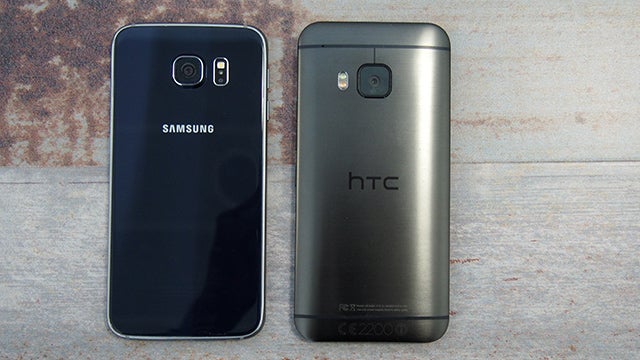
Galaxy S6 or One M9? We’ve lived with Samsung and HTC’s Android phones to help you decide
If you’ve read our reviews, then you’ll know that Samsung’s Galaxy S6 and HTC’s One M9 are great Android phones in very different ways.
They both have top-end specs, and need to sell in the tens of millions to remotely touch expectations. But which one should you buy?
Well there’s a lot of things so consider, but unlike so many of these comparisons, we think there’s actually one clear victory this time.
Read on to find out which one we side with, as we compare everything from design and screen to the little connectivity extras they pack in.
VIDEO: Galaxy S6 vs iPhone 6 vs HTC One M9 group test
Samsung Galaxy S6 vs HTC One M9: Design
Galaxy S6: Aluminium and Gorillas Glass 4, 6.8mm thick
One M9: Aluminium, 9.6mm thick
Last year, the HTC One M8 easily beat the Galaxy S5 on design. Slick metal versus thin plastic isn’t much of a competition. However, Samsung is not happy to just lay down and take a pummelling this year.
The Galaxy S6 uses a mix of metal and glass, providing a much harder, more expensive feel than any previous Galaxy S-series phone. Its back and front are mostly-flat panes of Gorilla Glass 4, with some tiny bits of contouring at the ends for comfort.
Its sides are aluminium, giving the phone a design that’s not 100 miles away from the Sony Xperia Z3. While it may not look all that different from the Galaxy S5 style-wise from a distance, the whole style has changed.
SEE ALSO: One M9 vs M8: Should you upgrade?
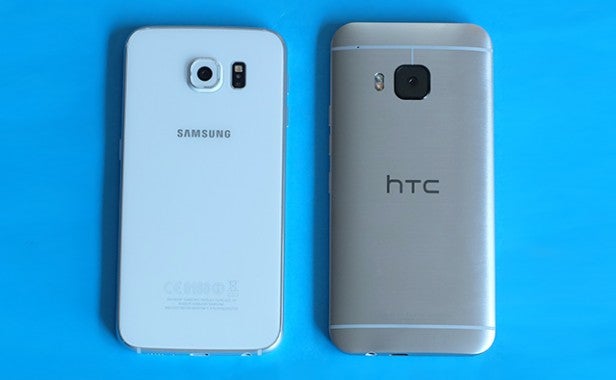
The HTC One M9 makes no such bold moves. It didn’t need to. Its style is very, very similar to that of the HTC One M8. The body is aluminium, with a brushed finish on the rear showing off the metal look.
Both phones feel great. Which one is better? As they all use top-quality materials, it’s largely a case of personal preference when we talk about the tactile qualities of these designs.
When warmer, the glass of the Galaxy S6 can start to feel a bit like plastic, where aluminium always feels, well, metallic. However, it’s by no means enough to give HTC this victory.
Let’s forget the fluff for a minute and ask: what are they actually like to use? On first feel, the HTC One M9 has slightly better ergonomics. Despite being significantly thicker (9.6mm to 6.8mm), the curve of the M9’s back hugs your hand in quite a comfy way.
Watch our hands-on with the Samsung Galaxy S6 Edge
However, after using the phones for quite a while, we do find the Galaxy S6 that bit easier to use one-handed. Despite being boxier, it feels like the slighter device, and the fingerprint scanner is a very intuitive way to bring the phone out of standby.
Like the iPhone 6 TouchID sensor, you just need to put a finger on the home button. And it works just about every time. It’s a huge improvement over last year’s swipe-y Galaxy S5 scanner.
The HTC One M9 doesn’t have a scanner at all, instead relying on the power button on the side. It’s within thumb-friendly reach, but then so is the Galaxy S6’s power button.
For pure usability we think the Galaxy S6 clinches it, but we recommend having a feel of each phone on the high street if possible. Some of you may not love that glassy feel.
If you have very deep pockets, you should also check out the Galaxy S6 Edge. It’s very similar to the S6 but has sides that curve around at the very edge. It sounds like a gimmick but looks and feels amazing. It’s this year’s top show-off phone, no doubt.
There is also some concern over such heavy use of glass. Will it shatter? Perhaps, while Gorilla Glass 4 is currently the best thing for this job, no glass is immune to shattering if you drop it from 10ft onto concrete.
Unless you’re seriously clumsy, though, don’t hinge your decision on this point. Drop the HTC One M9’s metal back onto concrete and it’ll earn some pretty serious battle scars too. Aluminium is relatively soft.
SEE ALSO: Samsung Galaxy S6 vs S6 Edge: What’s the difference?
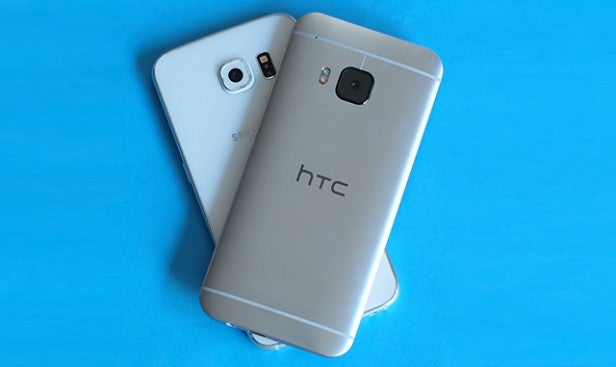
Samsung Galaxy S6 vs HTC One M9: Colours
Galaxy S6: black, white, gold, blue
One M9: gold/silver, grey
Care about colours? These phones are available in a few shades at launch, and we expect to see a few more appear as their shelf life trundles on.
The lightest HTC One M9 shade is bright silver, with gold-inflected coppery sides, while the Galaxy S6’s lightest shade is white. As the Galaxy S6 keeps the sides’ aluminium bare, both end up with a two-tone finish style.
Going to the darker end of the colour scale, the Galaxy S6’s black shade actually has a dark blue accent when reflected in the light. The One M9 makes the most of its metal body by opting for a charcoal finish. Both of these are a bit lower-key than the white/silver versions.
Samsung also offers blue and gold versions of the S6, although they appear to be less readily available than the other shades.
Watch our hands-on with the Samsung Galaxy S6
Samsung Galaxy S6 vs HTC One M9: Storage
Galaxy S6: 32/64/128GB, no microSD
One M9: 32GB, microSD
The Samsung Galaxy S6 is a huge upgrade in terms of look and feel for the S series. However, it also cuts out what has been a draw of the range since its beginning: there’s no memory card slot.
After leaving the microSD slot out of the original HTC One, the M8 and M9 have a card slot. People really weren’t happy when HTC made the same move Samsung just tried.
Does it matter? If you want a phone that’s going to hold a serious music collection you’ll need to upgrade to the 64GB or 128GB Galaxy S6, where 64GB cards for the ‘default’ 32GB One M9 can be had for £20.
Upgrading the Samsung phone will cost many times this, with 128GB Galaxy S6s expected to sell for £800.

Samsung Galaxy S6 vs HTC One M9: Screen
Galaxy S6: 5.1-inch 2,560 x 1,440 Super AMOLED
One M9: 5-inch 1,920 x 1,080 Super LCD3
Sorry HTC, Samsung has this one in the bag. The Galaxy S6 has a fantastic screen, the One M9 a good one.
You might think this rests on resolution: the S6 has a QHD screen, the M9 a lower-end Full HD one. However, it doesn’t really.
Both screens are very sharp, with the difference only becoming obvious when you get so close it’s bad for your eyes. Up-close you can see a slight texturing to areas of block white on the One M9 that gives away the lower resolution, although it’s likely to be down as much to the specific qualities of the panel, not just the resolution.
What really sets the Galaxy S6 apart are the benefits of its Super AMOLED panel. Its contrast and black level destroy the One M9’s, whose screen is limited by the way LCD screens work (in using a backlight).
SEE ALSO: iPhone 6 vs Samsung Galaxy S6

The Galaxy S6 also lets you choose whether to use ‘accurate’ or highly saturated colours, or something in-between. That said, the tone of the HTC One M9’s screen is very nice too, avoiding oversaturation.
Screen pedants will love the Galaxy S6. However, most people will be happy with either display.
For more practical purposes, where the Galaxy S6’s screen shines is outdoors visibility. It has much more dynamic daylight compensation than the One M9, keeping its screen clear in any conditions. The wide colour gamut of the S6 lets it massively ramp up the colours when it’s dealing with bright daylight. It’d look terrible indoors, does the job for sunny days.
The One M9’s outdoors performance is fine, but ultimately ordinary. Reflections can get annoying.
Samsung Galaxy S6 vs HTC One M9: Connectivity
Galaxy S6: 4G, Wi-Fi ac, Bluetooth 4.1, NFC, IR, heart rate sensor
One M9: 4G, Wi-Fi ac, Bluetooth 4.1, NFC, IR
We’re not dealing with iPhones here: these Androids have seriously impressive wireless connectivity skills. As well as Bluetooth 4.1 with apt-X support, 4G, ac Wi-Fi and NFC, you get an IR transmitter that lets these phones double as universal remote controls.
Both phones actually use the same app for this, called Peel Smart Remote. It’s pretty handy.
For 99 per cent of people, both phones cover all important bases. However, the Galaxy S6 has a few little extras too. There’s a barometer and a heart rate sensor on the back, and the mobile internet and Wi-Fi connections can be used simultaneously for turbo downloads.
Don’t get too excited about the heart rate sensor, though. We find that like last year’s Galaxy S5, it can struggle to lock onto your heart rate and you can get similar results by using a third-party app that uses the LED flash and camera instead.
SEE ALSO: LG G4 review: How does it compare to the S6 and One M9?
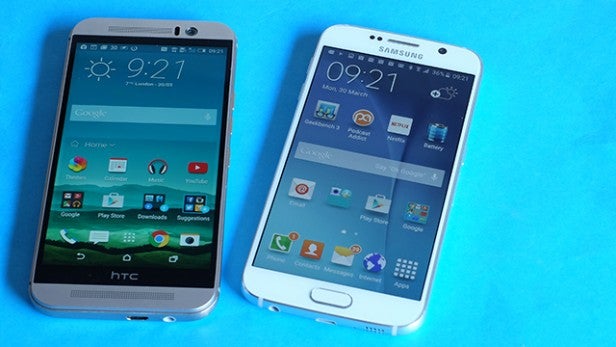
Samsung Galaxy S6 vs HTC One M9: CPU and RAM
Galaxy S6: Exynos 7420 2.1GHz with 3GB RAM
One M9: Snapdragon 810 2GHz with 3GB RAM
Before the Galaxy S6 launched, a big fuss was made of Samsung’s decision not to use a Qualcomm CPU. It used Qualcomm chipsets for lead territories with the last three S-series flagships.
However, looking at the results we can understand why. As well as being Samsung-made, the Exynos 7420 CPU outperforms the Snapdragon 810 in our benchmark tests.
In Geekbench 3, we got as much as 5200 points out of the Galaxy S6, and around 4400 from the HTC One M9. That’s a big difference. So why is it so much better when both chipsets have eight cores, four of which use Cortex-A57 CPUs as their real power engines?
SEE ALSO: Octa-core vs Quad-core: Does it make a difference?
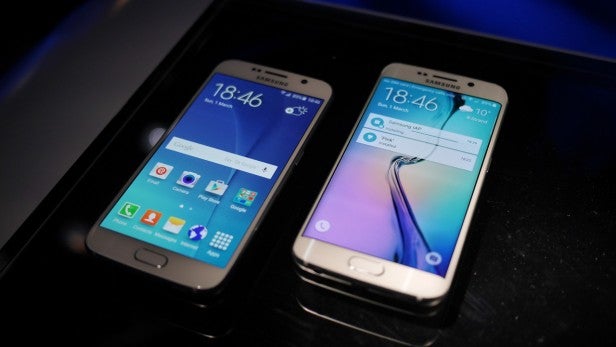
The Exynos 7420 uses a more advanced 14nm production process (the Snapdragon 810 is 20nm) that helps its efficiency. Of course, this bonus power is rarely apparent.
Both of these phones run like a dream, and have no trouble tackling Android’s most challenging 3D games. However, the difference in chipsets is not meaningless.
We’ve found that the Galaxy S6 manages heat a bit better. Quite simply, it doesn’t tend to get as hot as the HTC One M9. As we’ll discuss in a bit, it also has a big effect on battery life.
Contrary to what some voices on the internet suggest, though, we’ve not had any issues with the HTC One M9 full-blown overheating. It just gets a bit warmer than the S6.
Samsung Galaxy S6 vs HTC One M9: Software
Galaxy S6: Android 5.0 with TouchWiz
One M9: Android 5.0 with Sense 7.0
Both phones run Android 5.0. Both phones run fast. So which has the best software?
A couple of years ago we much preferred HTC’s custom Sense interface to Samsung’s. However, over the past couple of years Samsung has made more progress than HTC, and they’re now much closer quality-wise than they used to be.
The One M9 has better interface themes, which both now offer, but it’s actually easier to strip back the Galaxy S6 software.
Both also have a homescreen dedicated to online updates: Samsung has Briefing (powered by Flipboard), HTC has BlinkFeed (powered by News Republic). They’re both pretty good, but plenty of people will want to ditch the lot.
They are both good interfaces, capable of standing next to vanilla Android without seeming like poor custom builds. So the question really is, which do you like the look of?
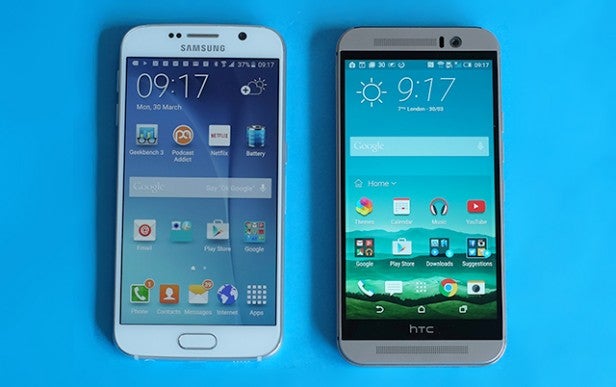
Samsung Galaxy S6 vs HTC One M9: Camera
Galaxy S6: 16-megapixel rear, f/1.9, OIS, LED flash, 5-megapixel front
One M9: 20-megapixel rear, f/2.0, dual-LED flash, 4-megapixel front
HTC has delivered some of the more contentious phone cameras over the past two years. The HTC One and One M8 used UltraPixel sensors for their main cameras, with deliberately low-res brains to deliver higher fidelity images, particularly in lower light.
That strategy has changed. There is an UltraPixel sensor here, but it’s on the front rather than the back. The main camera is now a 20-megapixel sensor, one of the highest-res models around.
Its style is therefore quite similar to the Galaxy S6’s setup, which uses a 16-megapixel rear sensor and a 5-megapixel front one. Is it a case of more megapixels, better pictures?
Not quite. In fact, the two phones take pictures of almost the same resolution unless you switch the shape of your pics. The HTC One M9 as a non-widescreen sensor, meaning that when it takes 16:9 pics (the default) it crops into the sensor, rubbing away some of that resolution.
The Galaxy S6, on the other hand, has a 16:9 sensor. None of the pixels go to waste. Don’t believe the numbers at face value, in other words.
In the right conditions, both of these phones can take fantastic pictures. However, the Galaxy S6’s camera brain is a lot more intelligent, meaning you end up with far fewer duds.
The key element that is slightly faulty in the One M9 is metering, where a camera judges how bright a photo needs to be. This isn’t about the camera ramping up/down a brightness slider, but choosing the ISO setting and exposure time.
Metering in the Galaxy S6 is very reliable, almost iPhone-like, where the One M9 is quite prone to overexposure. Not only does this blow out details, which are non-retrievable, but can cause bleeding of highlights into surrounding parts of the image. And that just looks rubbish.
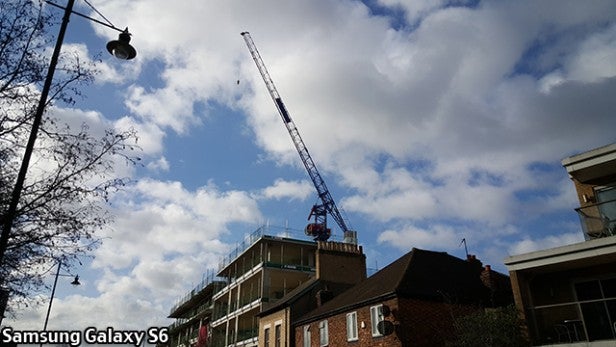
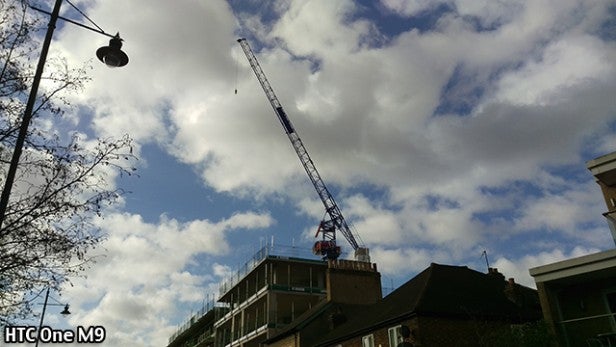
In the shots above, white balance and dynamic range (/metering) are better in the S6
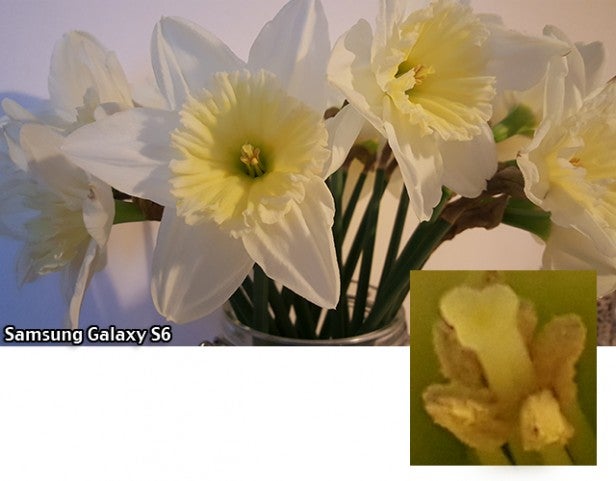
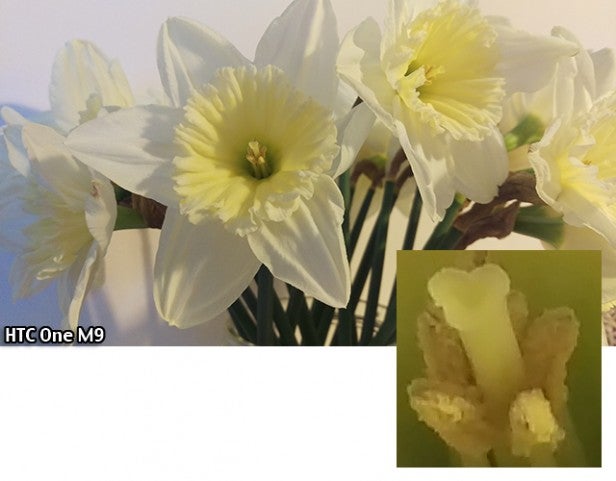
Low-light performance is significantly better in the Galaxy S6 too. This is no surprise. It has optical image stabilisation, the HTC One M9 doesn’t. We’d describe the One M9 low-light performance as ordinary rather than bad: it’s more the case that the Galaxy S6 is quite good despite having a high-res sensor (which can cause lesser low-light performance).
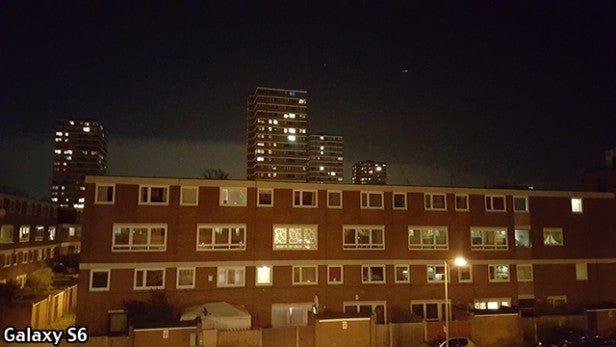
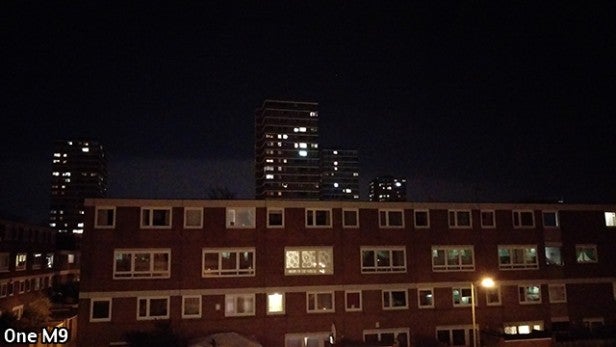
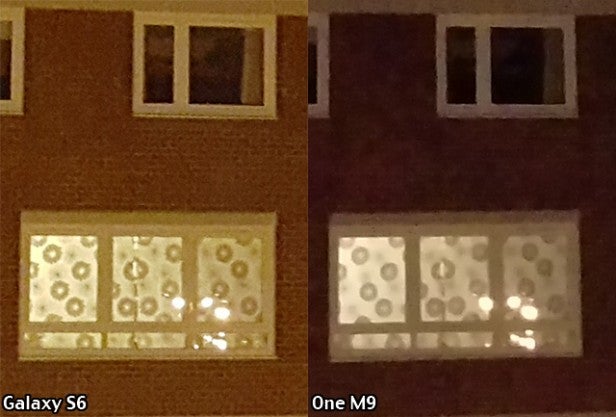
Notice that the brick texture is mush in the M9 shot, but visible in the S6
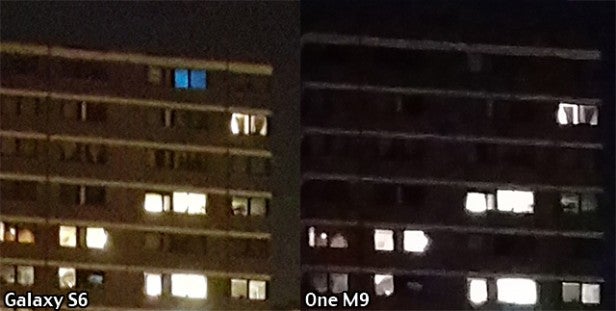
These tests show clearly how much better the S6 is at low-light photography
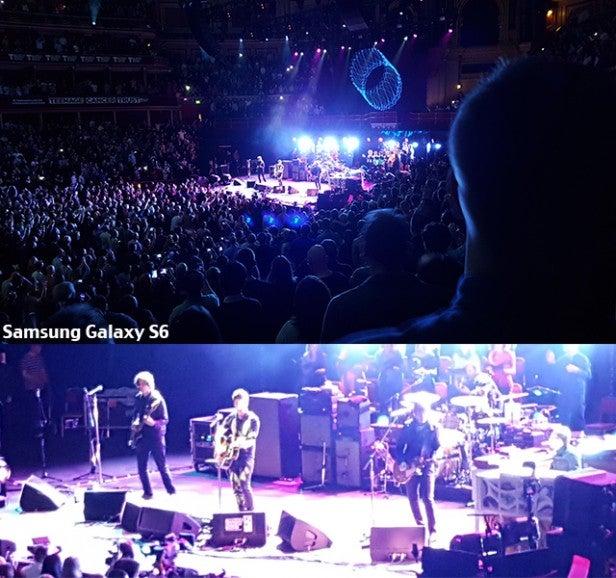
HDR mode is much better in the Samsung too. Not only is it quicker and easier to access, the results are superior.
What the HTC One M9 has an edge on is general speed. It’s extremely fast, especially in lower lighting. The Galaxy S6 is not slow. It’s actually reasonably nippy in all conditions, but the performance depends a lot on the lighting, as it clearly takes the surroundings into account an awful lot. The One M9 is fast all the time, unless you shoot HDRs. Its HDR mode is a touch slow.
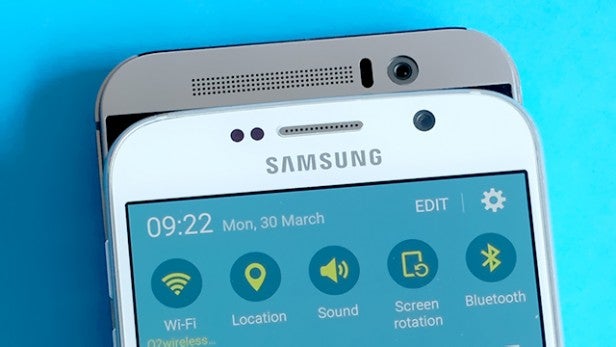
The HTC One M9 does win out for selfies, though. Despite having a 4-megapixel sensor to the Galaxy S5’s five mega’s, those UltraPixel powers don’t half come in handy.
While the front camera is also prone to some exposure problems, it’s better at holding onto details in indoors and poor lighting than the Galaxy S6 selfie shooter. For bonus dingy bar skills, the One M9 wins. But only for selfies.
Samsung Galaxy S6 vs HTC One M9: Battery Life
Galaxy S6: 2550mAh, non-removable battery, Fast Charge technology
One M9: 2840mAh, non-removable battery, Quick Charge 2.0 technology
Battery life of these phones is complicated, a little confusing and ultimately disappointing, for the One M9 at least. The HTC One M9 has a larger battery than the Galaxy S6, with 2840mAh 5v capacity to the Galaxy S6’s 2550mAh.
The big surprise is that the Galaxy S6 trashes the HTC One M9 for stamina in most conditions regardless. When playing back a 720p MP4 file at middling screen brightness on loop, the HTC One M9 lasts for around 9.5 hours where the S6 soldiers on for an excellent 13.5 hours.
It’s also better in normal use. It is simply far too easy to run down the HTC One M9 in a day, where with normal use we got (with normal light-ish use) til 4pm on day two with the Galaxy S6. Turning on power saver mode, we got to 9pm on day two without needing a charge. Impressive stuff.
So why is the Galaxy S6 so much better while having a smaller battery? HTC may be able to improve this with future software updates, but it seems the 14nm architecture of the Galaxy S6 is likely to play a big part.
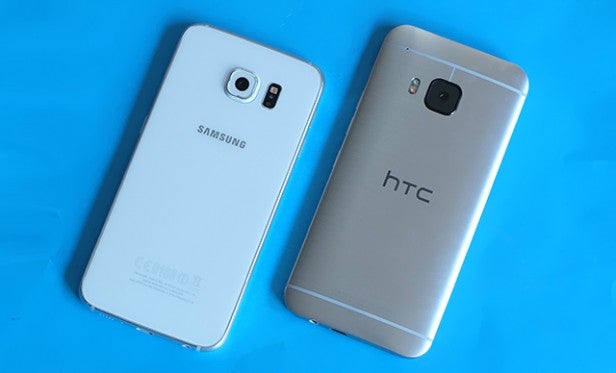
Samsung Galaxy S6 vs HTC One M9: Speaker
Galaxy S6: Single, on bottom edge
One M9: Stereo BoomSound on front
Traditionally HTC has easily bested Samsung for smartphone speakers. That hasn’t changed this year, but the competition just got a lot closer.
Samsung has changed from using a single rear speaker to a single speaker on the bottom edge. The HTC One M9 uses a pair of BoomSound speakers on the front.
Despite using a single driver, the Galaxy S6 is actually louder. And its mid-range and bass response has improved hugely since phones like the Galaxy S4 and Note 4. It’s pretty good.
However, for fidelity and sound quality, the BoomSound pair of the One M9 still win. They don’t sound strained at max volume, unlike the S6, and they’re just that bit smoother and more refined.
SEE ALSO: HTC One M9 vs iPhone 6

Verdict
The Galaxy S6 and One M9 both make improvements over last year’s models. However, the Samsung phone’s updates are more important, and generally far more successful.
The fingerprint scanner, the screen, the design and even the camera have all been improved significantly. HTC has not made as many changes to the One M9, and not every change is quite as dramatic or successful as we’d like. It hinges on the camera: it’s still not consistent enough. Battery life is also disappointing.
Supporting HTC has felt a bit like supporting the underdog in the last few years. And we like doing that, but this time Samsung seems to have flat-out beaten HTC.
Are you planning to buy the One M9 or the Galaxy S6? Let us know your thoughts on the new flagship phones below


